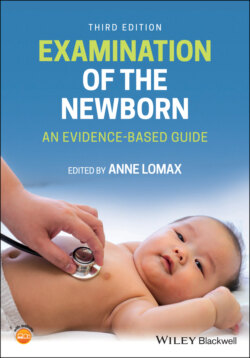Читать книгу Examination of the Newborn - Группа авторов - Страница 38
Increased risk of cardiac anomalies related to newborn
ОглавлениеSibling: Recurrence of 2–3% in a subsequent sibling increasing to a 50% recurrence rate in three affected siblings.
Parental cardiac anomaly: 2–5% risk to infant.
Maternal diabetes: 2% risk to infant particularly in uncontrolled diabetes.
Drug‐related teratogens: For example, phenytoin, 2% risk to infant (adapted from Sharland 2010).TABLE 1.4 Predictive risk factors with potential impact upon newborn outcome including the NIPE Programme national risk factors.Source: Adapted from the NIPE Screening Programme Handbook (2020c) and cited references.The four NIPE screening elements and othersRisk factorsSpecific conditionIntergenerational trait statusHipsFirst‐degree relative with DDH (national NIPE Programme risk factor) Risk factors: persistent breech presentation or breech delivery (national NIPE Programme risk factor)Developmental dysplasia of the hipsPositive Eyes First‐degree relative with congenital eye condition (national NIPE Programme risk factor) Congenital cataracts if syndrome associated Glaucoma RetinoblastomaPositiveHeartFirst‐degree relative with CHD (national NIPE Programme risk factor) Major CHD on fetal anomaly scan (national NIPE Programme risk factor) Previous SIDSCongenital heart defect Cardiac conduction mechanism disorders, e.g. prolonged QT syndrome, Wolf–Parkinson–White syndromePositive (dependent on cause)TestesFirst‐degree relative with cryptorchidismUnilateral or bilateral undescended testes – bilateral very significantPositiveSignificant othersSiblings First‐degree relative IntergenerationalChromosomal aberrations Genetic disorders Structural anomalies Syndromes Inborn errors of metabolismPositiveFirst‐degree relative First‐degree relative (sibling)Severe congenital hearing deficit Jaundice treated with phototherapyPositive PositiveFirst‐degree relativeAtopy: Dermatitis Eczema Epidermolysis bullosaPositiveFirst‐degree relativeAsthmaPositive (multifactorial variables – genetic, environmental)IntergenerationalHaemoglobinopathies, e.g. thalassaemia, sickle cell diseasePositiveFirst‐degree relativeTongue tiePositiveIntergenerationalMarfan syndromePositiveIntergenerational/first‐degree relativeMyasthenia gravisPositive
Intrinsic fetal anomalies: Incidence increased in the presence of other fetal structural or chromosomal anomalies, e.g. the triad of trisomies 21,18 and 13.
Transplacental viral transmission: Increased risk of CHD.
Parental consanguinity: Increased risk of CHD (Ramegowda and Ramachandra 2006; Khalid et al. 2006).
Psychotropic drugs: Teratogenic and newborn effects, e.g. paroxetine may increase the risk of ventricular septal defect, lithium may increase the risk of Ebstein's anomaly.
